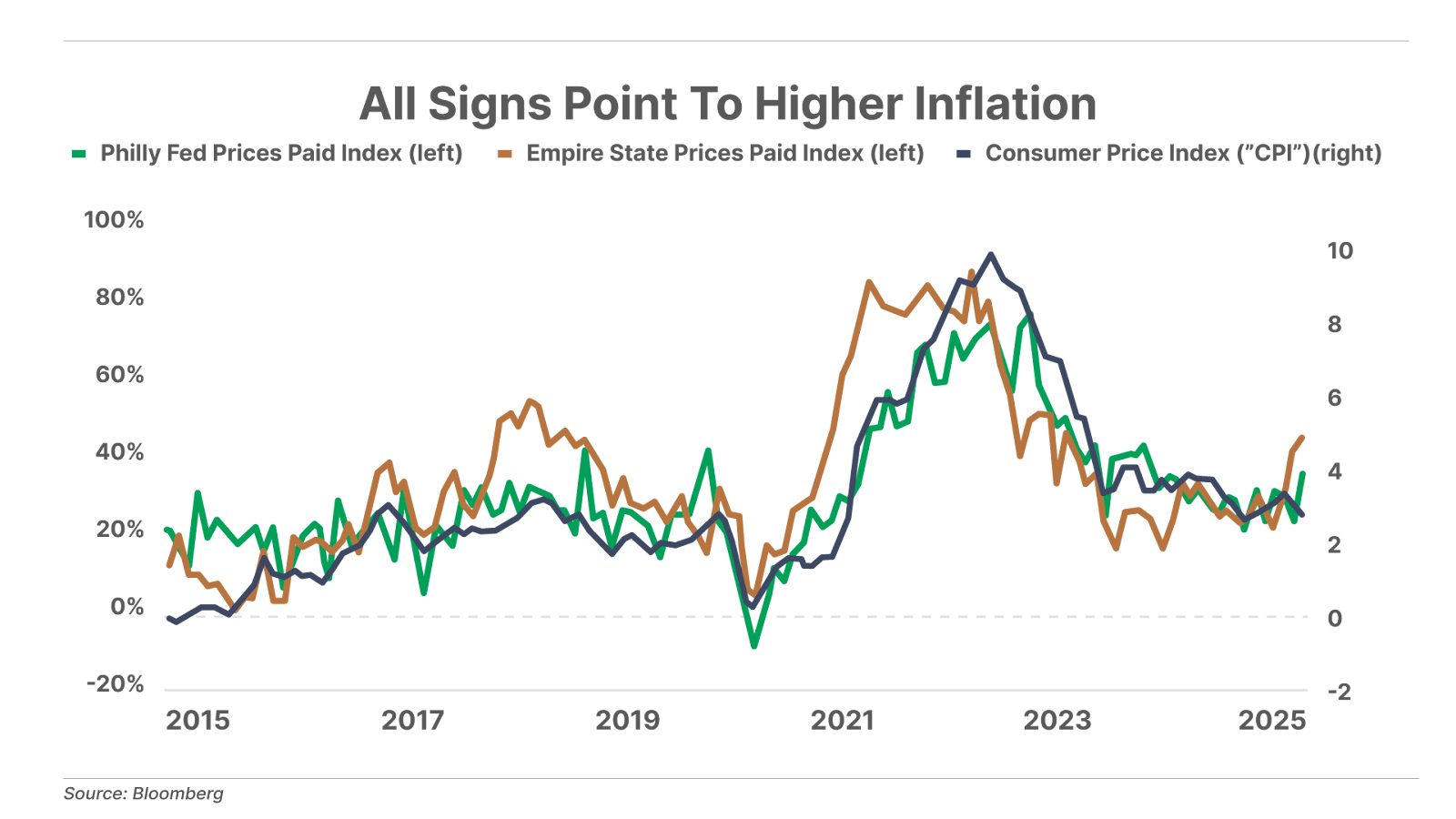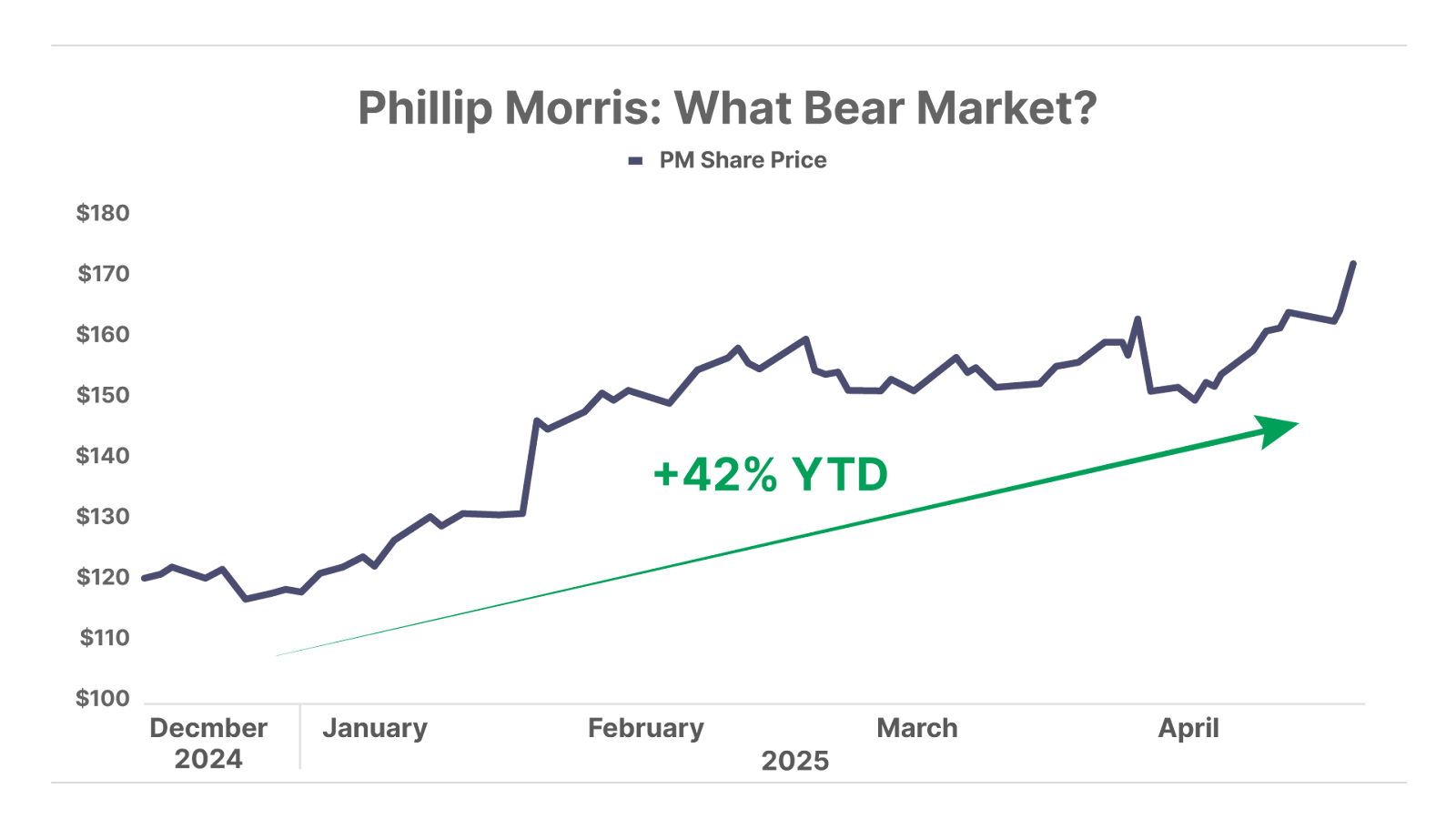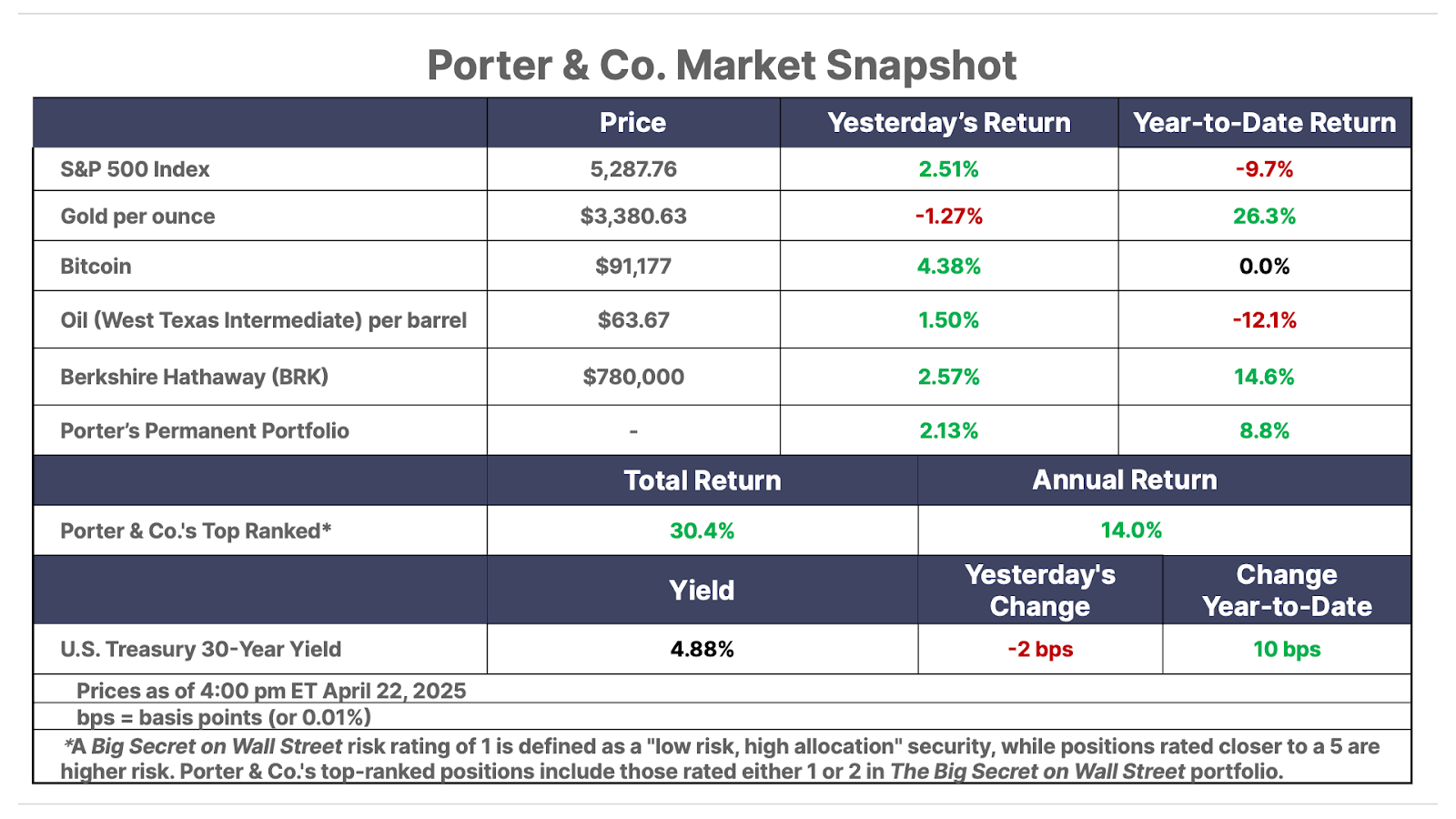Issue #46, Volume #2


How New Technology Inside Capitalism’s Oldest Industry Created America’s Best New Business
A Small Group of Our Subscribers Are Making ~ 50% A Year
— This Is Your Invitation To Join Them —
This is Porter’s Daily Journal, a free e-letter from Porter & Co. that provides unfiltered insights on markets, the economy, and life to help readers become better investors. It includes weekday editions and two weekend editions… and is free to all subscribers.
| Some moments can change your life forever… Your opportunity to join me for one of these experiences next month… The real secret to Buffett’s world-beating returns… A rare chance to invest in the “next” Berkshire Hathaway… The ultimate safe haven in 2025… |
“I suddenly realized that we were all going to become very rich…”
Have you ever had that experience, an incredible flash of insight, when you were suddenly sure that your life was going to change forever?
Have you experienced a ‘singularity,’ when, all of a sudden, you could see years of the future unfolding with picture-perfect accuracy?
Maybe it was when you closed on a successful real estate deal. Or maybe it was when you received an incredible assay from a mine.
Or, in my business, it has happened when I’ve published an important new story, like my End of America documentary. Or when one of my new products has completely taken off on day one, like my razor, OneBlade (https://www.onebladeshave.com/).
Not all of these moments are about money or business. It happens when you fall in love with your spouse, or when your first child is born. In that moment, you know everything – absolutely everything – in your life is going to change.
These moments happen. And they shape our lives.
I’m inviting you to join me for a moment like that next month in Richmond, Virginia.
Imagine 50 years ago someone invited you to Omaha, Nebraska to have dinner and then to attend the annual meeting of a little-known insurance company, Berkshire Hathaway. Would you have gone? Imagine someone trying to explain to you that Berkshire wasn’t a textile company anymore (not really anyways) and that it was becoming the very best property and casualty insurance (“P&C”) company in the world.
Would you have believed them?
Fifty years ago was a period much like today, with serious macroeconomic turmoil and an ongoing “reset” of the global financial system.
And so, I’d bet it would have been virtually impossible to get you to attend that meeting. Or to buy even a single share of that stock to earn your credentials for Berkshire’s annual meeting.
“Property and casualty … what…?” you’d most likely say. Followed, undoubtedly, by a comment about gold, “Why would I buy stocks when gold is soaring?” Fifty years ago, gold was newly available to investors after being outlawed from 1933-1974.
And yet, over the last 50 years, Berkshire has outperformed every single mutual fund in the entire world. In fact, the quantitative hedge fund AQR found that, out of every conceivable publicly available investment option over the last 50 years, Berkshire has performed the best, with 19% annualized returns.
How did Buffett do it?
Most people think it was from great equity investments, like Apple and Coke. And yes, that’s part of it. Buffett is a great investor, with returns on capital invested of around 12% a year. That’s better than the market, but not absolutely world-beating. So, what created most of Berkshire’s “alpha” – the profit in excess of market returns?
It was good investing paired with a huge amount of leverage!
Buffett used about 60% leverage, on average, over the period. But his funding source wasn’t a margin loan, it was insurance “float.”
That’s the premiums that were paid to Berkshire’s insurance subsidiaries. Buffett could use these funds until claims on the policies had to be paid.
In short, the reason why property and casualty businesses can beat the market so consistently, for so many years, is because – if their underwriting is good – they get access to capital for free.
That’s a virtually unbeatable advantage.
If you study Berkshire, you’ll discover that, over the last 50 years, its insurance float has grown by 21% annually, an amount almost perfectly correlated to its total returns.
What’s this got to do with dinner in May?
Let me explain…
I used to tell investors that if there was only one thing I could teach every investor, it would be to never, ever buy a stock. Why? Because I’m convinced that most investors aren’t emotionally equipped to handle the volatility associated with owning equities. And, for those people, buying corporate bonds – especially when they trade at a discount to par – is a far better option.
When you buy a bond, you know, up front, exactly what your return will be – if you hold until maturity. For most people, that’s the hard part – holding. Sitting on your hands. Letting the storm pass.
Everyone, it seems, wants to “time the market,” when what they should focus on is “time in the market.” But, with bonds, because you typically have to hold until maturity to earn high returns and because bonds are legal obligations – coupons and principal must be paid on time and in full – most people do hold until maturity.
As a result, I’ve seen that most people get better results from buying bonds (at a discount from par) than from buying stocks.
But I’ve recently changed my mind…
Going forward, what I’m going to try my hardest to teach our subscribers is how to invest in property and casualty insurance stocks.
These companies primarily invest in corporate bonds, so they’ll do all of that difficult bond investing for you. They will manage duration risk and credit quality, for free. That saves you a lot of time and hassle. But that’s not the best part. The best part is that when you buy bonds via insurance stocks, just like Buffett, you’ll get the enormous advantage of the “float” – of getting so much capital for free.
I started studying property and casualty insurance in 2012. I hired two analysts who had experience as auditors. They were familiar with the accounting processes of these firms. That’s critical because management teams in this industry are given wide leeway in estimating future insured losses, which can inflate earnings.
The risk of incompetent or dishonest management is one reason these stocks rarely trade at expensive multiples. The other reason investors tend to shun the sector is that analyzing these companies isn’t easy. But, I wanted to master the industry, to understand everything I could about every stock in the sector.
I built a multi-factor industry model, bought a ton of data, and – using custom-built software – began rating every publicly traded P&C stock, beginning in June of 2014.
How did my model perform?
If you bought the top ten stocks my model showed were the best and rebalanced your portfolio quarterly (like an ETF, or an index would), you would have earned 26.8% annualized returns over the last decade. You would’ve earned a total return of 371% versus 248% for the S&P 500. And you would have done so with far less volatility than the market, too.
I don’t know of a better strategy over the past decade. And I don’t believe there’s a better, lower-risk way to beat the market by such a wide margin, over a long period of time. If you want market-beating results that you can count on, in an industry that’s quite literally the foundation of capitalism, my best advice is to become an expert in property and casualty insurance.
And that’s why I’m inviting you to join me for dinner on May 21!
I want a chance, in person, to explain everything I know about this industry and what you should be looking for as an investor in the space.
That way, you’ll be fully prepared to attend the annual meeting of Kinsale Capital (KNSL) with me on the following day, May 22.
Obviously, you’ll have to be a shareholder to attend the annual meeting. But you absolutely should be a shareholder of Kinsale Capital.
Why am I so sure?
We’ve done very well for our subscribers in property and casualty. We’ve accurately picked out the very best companies, which have proven themselves – over decades – to be excellent investments. There’s a world of difference between a stock that goes up 50% in one year and a stock that goes up 16% a year for decades.
When you invest for the long term in property and casualty, you’re not playing checkers. You’re playing chess. It’s a difference that can build generational wealth for you and your family.
And we’ve found many great businesses in the P&C industry that can do that for investors: RLI (16.6% annualized since 1985, 48,000% total return); Progressive (19.5% annualized since 1983, 163,000% total return); WR Berkley (16.6% annualized since 1984, 49,000% total return).
But, as great as these businesses are, they aren’t Kinsale.
As I’m certain I can prove to you, Kinsale is in a league of its own. It is the very best property and casualty insurance business in the country today.
In that regard, it is very much like Berkshire 50 years ago, only better.
That would sound outlandish, if it wasn’t true. But it’s simply a fact: Over the last nine years (since it went public) Kinsale has produced 48% annualized gains, good for total returns in excess of 3,000%.
If you doubt anything I’m saying here about the company, just listen to its quarterly call – scheduled for Friday morning at 9:00 AM ET – right here.
Listen to what the company says about its industry-leading expense ratio and its industry-leading combined ratio. Listen to what the management team says about its enormous technological advantage over its competitors.
Also, be aware, historically, the stock sells off when its earnings are posted. Not because the results are bad, but because of the “buy the rumor, sell the news” phenomena of short-term traders.
You should ignore all of that “noise.” If you do, you’re very likely to see annualized gains of 20%+ for the next two or three decades.
Subscribers to The Big Secret on Wall Street should be very familiar with Kinsale, as we first recommended it about a year ago (May 17, 2024).
Normally we don’t give away investment ideas in this Journal – and certainly not our very best ideas. But Kinsale is a generational opportunity. Kinsale is the kind of stock that can change everything for you as an investor. It’s a singularity, if you can understand it.
I do not say this lightly: you could probably put your entire portfolio into just this one stock. It’s one of my largest investments, personally. And that’s why I’ll be attending Kinsale’s annual meeting every year until I die.
I sincerely believe that if you attend this meeting, it will change your financial life, forever.
So, what is it going to be?
Are you going to keep doing what you’ve done for years? For most of you, that’s “buy and fold” investing. Churning your account. Always chasing the latest “hot” thing.
Or, will you make a commitment, today, to become a great investor? If you want to produce real, lasting, and generational wealth as an investor, building a portfolio around a business like Kinsale is the very best option – and it’s not a close call.
Come have dinner with me in Richmond.
I’ll teach you everything I know about property and casualty investing. I’ll show you the industry model that I built in 2012, which has produced incredible results for more than a decade. And I’ll make sure you understand exactly why Kinsale is likely to be one of the best-performing stocks of the next decade and beyond.
This is it. You’ve never, ever gotten an invitation like this before. And you probably will never have an opportunity like this again.
This is your golden ticket to a better financial future.
But will you do it?
Hope to see you there – click here to join me.
Chinese Issue NEW Financial Threat to America
The global economic war has arrived.
This announcement from China means they are set to implement massive tariffs on America any day now.
Are you going to learn how to leverage this global trade war to potentially generate returns 1,000% or more in a matter of months as this plays out?
Or are you going to sit on the sidelines and become one of the victims in this new economic war?

Three Things To Know Before We Go…
1. Trade headlines continue driving the market. On Tuesday afternoon, President Trump said U.S. tariffs on China would “come down substantially,” sparking a rally that pushed the S&P 500 up 2.5% and the Nasdaq 100 up 2.7%. Treasury Secretary Scott Bessent followed by signaling a de-escalation with China was in motion. And later, The Wall Street Journal reported the U.S. plans to cut China’s tariff rates from 145% to a range of 50% to 65% – a step toward easing tensions, though still leaving in place tariffs more than double what they were when Trump took office. But Bessent walked things back this morning – clarifying that the U.S. isn’t offering a unilateral cut – and warned that a comprehensive deal with China could take two to three years. As the back-and-forth continues, one thing is clear: the uncertainty isn’t going away anytime soon.
2. Inflationary pressures are rising. While official measures of inflation have been moving lower over the past few months, we continue to see signs that this trend could be short-lived. Two widely followed regional surveys – the Philadelphia Fed Manufacturing Business Outlook Survey and the New York Fed Empire State Manufacturing Survey – both show manufacturing input costs are rising sharply for the fourth consecutive month. The Philadelphia Fed Prices Paid index jumped to 51 in April, the highest level since July 2022, while the Empire State Prices Paid index rose to 50.8, the highest since August 2022. These indexes have historically acted as leading indicators for the consumer price index (“CPI”), suggesting headline inflation may be headed higher in the months ahead.

3. Philip Morris: the ultimate safe haven in 2025. Philip Morris delivered another blowout performance from its smoke-free product portfolio in its latest Q4 results this morning. This included 53% volume growth from its ZYN brand, the world’s most popular nicotine pouch. The company has transformed from a dying tobacco business into the world’s fastest-growing smoke-free nicotine brand, with 44% of gross profits now coming from smoke-free products. The stock has returned over 100% since we recommended the company in the Big Secret on Wall Street at $90 in July 2022. It’s also become one of the few safe havens this year, offering a steady stream of earnings growth immune from the threat of a recession, global trade war, and virtually any other conceivable economic disruption.
Click here to become a member of The Big Secret on Wall Street and get access to all of our current recommendations, including our Top 3 “Best Buys” for new investors today.

Good investing,
Porter Stansberry
Stevenson, MD


Please note: The investments in our “Porter & Co. Top Positions” should not be considered current recommendations. These positions are the best performers across our publications – and the securities listed may (or may not) be above the current buy-up-to price. To learn more, visit the current portfolio page of the relevant service, here. To gain access or to learn more about our current portfolios, call Lance James, our Director of Customer Care, at 888-610-8895 or internationally at +1 443-815-4447.